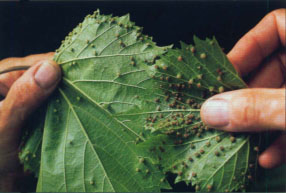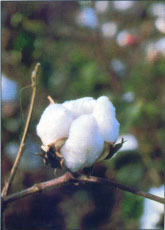All Issues
Science briefs
Publication Information
California Agriculture 52(6):4-5.
Published November 01, 1998
PDF | Citation | Permissions
Full text
New phylloxera may threaten nurseries
A new form of phylloxera — related to the subterranean insect that cost California's premium winegrape industry more than $1 billion in replanting costs during the last decade — has appeared in three grape nurseries over the last two years. One of UC's experts on the pest says the new type of phylloxera does not pose a major threat to growers who have switched to resistant rootstock.
The new form of phylloxera is a foliar or leaf-feeding pest as opposed to the earlier strain that attacks the roots, according to Andrew Walker, a UC Davis viticulture and enology professor. It forms tell-tale galls on the underside of fresh grape leaves in addition to attacking roots like the typical California strains of the pest. The finds thus far have all been on the leaves of rootstock varieties. To the relief of the grape-growing community, however, the pest does not appear to have an affinity for vinifera varieties such as merlot, chardonnay and cabernet sauvignon.
Although cases of the foliar phylloxera have been noted on wild grape plants in Southern California and elsewhere in the Southwest, the foliar form of this pest has only very rarely appeared in California's wine country before and never stayed more than a portion of a season. This form of phylloxera is common on the East Coast and in Europe, where the combination of high humidity with summertime rainfall is thought to be ideal for its survival. “It is possible that nurseries may have brought rootstock in from the East Coast and the foliar phylloxera may have come along,” Walker says. “That's all we know at this point about where it came from and how it got here.”
“It probably has very limited viticultural importance in California,” Walker says. “I think the issue is that it has big implications for the nursery industry. If the foliar form of phylloxera becomes widespread, it will be difficult to prevent low levels of phylloxera from establishing on resistant rootstock roots.”
Nurseries will have to spray several times per season to control the foliar form if it spreads, although pesticides do not control it completely.
Growers who have already switched from nonresistant rootstock such as AXR will not be affected. Growers who have yet to switch are at most risk — the Sierra Nevada foothills, Monterey Valley and portions of Mendocino and Sonoma counties — as they may inadvertently bring phylloxera into these areas on rootstocks from nurseries with low-level infestations.
The foliar-feeding phylloxera burrows itself into the leaf, where one female lays a couple hundred eggs. As the young emerge from small bumps or galls, they crawl toward the shoot tip, and begin feeding on new growth. Feeding can be severe enough to defoliate part of the vine. “They don't really fly very well,” Walker says, “but they can be blown in the wind. It's mainly propagation wood and people that move phylloxera around long distances. The root form is commonly spread on infested vine roots, but we're not quite sure how the foliar forms could move so quickly. They could be inside bud scales 01 under the bark near the buds.”
“Foliar forms of phylloxera are more of a nursery issue than a grower issue,” Walker summarized. “But we may now have these additional strains in the state. These new strains may not have a direct impact on resistant root-stock roots but they are likely to hasten the decline of nonresistant plantings, AXR plantings or own-rooted plantings.” — John Stumbos
UC, COS and high school to build dairy
The UC Davis School of Veterinary Medicine, the College of the Sequoias, and Tulare Joint Union High School District are working together to create the nation's first dairy education program jointly run by a high school, a community college, and a university professional school.
When completed, the California Dairy Technology Center will establish a 400-cow working dairy herd and a $2 million milking facility at the UC Davis Veterinary Medicine Teaching and Research Center (VMTRC) in Tulare. James Cullor, director of VMTRC, expects the dairy to be operational by the summer of 2000.
The site is located in the nation's top milk-producing county. “High school pupils can learn hands-on job skills, and college students may advance in technical dairy careers or other science studies,” says Bennie Osburn, dean of the School of Veterinary Medicine.
Visalia's College of the Sequoias and Tulare High School — the only high school in the United States with an on-site dairy program — have achieved the highest national recognition for their respective dairy vocational programs. Community growth has crowded existing operations on their respective campuses, making the timing right for a cooperative partnership, according to Cullor.
Construction funding is being secured from public and private sources, and the partnership will be run as a foundation. The dairy will pay annual expenses of about $900,000 from milk and dairy product sales. Osburn states, “We intend to run a self-sufficient venture. The project is designed so students can learn dairy management skills in a real-world setting.”
Change in law allows transgenic cotton
A historic change in the state's One-Quality Cotton District law took place this season and will become effective in the 1999 season. This change in the 73-year-old law opens the door to transgenic and other nonapproved cotton varieties. A reputation for high quality standards — including fiber strength, length and spinability — has traditionally earned San Joaquin Valley cotton an average premium of 7 cents per pound.
Under the old law, varieties had to be tested for at least 3 years and meet certain yield and quality standards before they could be eligible for acceptance by the San Joaquin Valley Cotton Board. The board is developing regulations, such as buffer zones between cotton fields, to prevent approved Acala and Pima varieties from being adversely affected by the varieties not approved by the board.
The California Department of Food and Agriculture (CDFA) will collect a seed assessment on nonapproved varieties to cover the cost of implementing the new regulations and to ensure that nonapproved varieties are identified through the growing, ginning and marketing processes.
Last year CDFA permitted breeders to plant as many as 2,000 acres per company for testing experimental varieties. “We now have about 7,000 acres of Roundup Ready cotton in private and university test plots in the San Joaquin Valley,” says Madera County Farm Advisor Ron Vargas, who has been working with the herbicide-resistant variety in test plots for 4 years.
This year, because planting was delayed by rain, growers received a special exemption to commercially grow unapproved cotton varieties that mature earlier. In May, Gov. Pete Wilson issued an executive order allowing commercial planting of nonapproved cotton varieties because El Niño's cool wet spring delayed planting. UC studies have shown that for every day after April 15 that planting is delayed, cotton yield is reduced 1% to 1.5%. Only 850,000 of the usual 1 million cotton acres were planted.
Of the 37,000 acres of nonapproved varieties planted under the exemption, 20,000 acres were transgenic cotton containing Bacillus thuringiensis (Bt cotton), according to Glenn Powell, regional manager of seed supplier Delta and Pine Land Co. “They seem to be yielding well,” Powell says. “I expect growers to plant 100,000 acres next year.”
However, farm advisor Vargas attributes the appeal of those lower quality Bt varieties to the higher yield potential in a short season rather than their pest resistance. He doesn't expect California growers to plant much Bt cotton despite the change in the law. “In California, we really don't have a fit the way they do in the rest of the Cotton Belt,” Vargas says. “Bt cotton is effective on pink bollworm and tobacco bud-worm, insect pests that we don't have.” (For more about Bt cotton, see page 14 .)
Mike Fraley, general manager of Germains Seeds, also doesn't anticipate widespread planting of Bt cotton. Of the transgenic varieties, he thinks growers will prefer those with herbicide resistance. “Next season 12% to 15% of the acreage will be planted to transgenic cotton, in my opinion; 10% will be Roundup Ready,” Fraley says.
The new short-season varieties will be called California Uplands and Pimas to differentiate them from the board-approved San Joaquin Valley Acalas and Pimas. Cotton grown in the Sacramento Valley will be identified as Sacramento Uplands.






